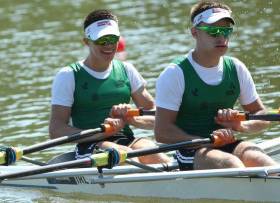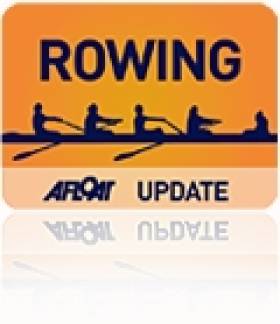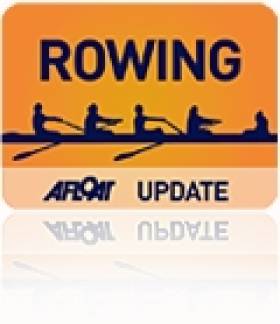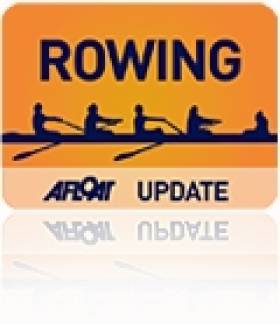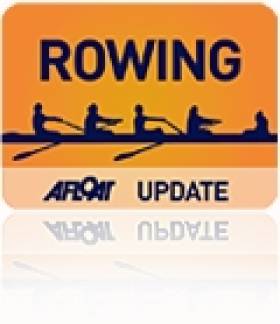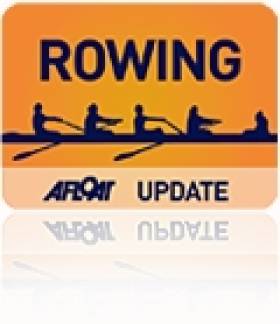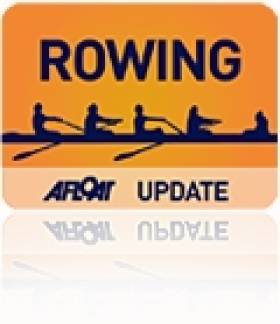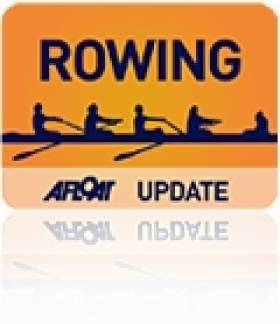Displaying items by tag: World Under23 Championships,
McCarthy Twins Just Off Final Mark at World Under-23 Rowing
#Rowing: Ireland’s lightweight double of Fintan and Jake McCarthy missed out on an A Final at the World Under-23 Championships by just one place. They finished fourth behind Canada, Spain and South Africa in an intriguing race which had a close finish.
Spain led through through the 500 and 1,000-metre marks, with Ireland towards the back of the field. Canada took over the lead in the second half and went on to win. Behind them, Spain clung on to second. Three boats vied for the the vital third spot: South Africa, Ireland and Britain. Ireland had a good second quarter and were back in the mix with a good finish, but South Africa had the best final 500 metres and took third, less than a second ahead of Ireland. Britain were fifth.
World Under-23 Championships, Plovdiv, Bulgaria (Irish interest)
Men
Lightweight Double Sculls – Semi-Finals (First Three to A Final; rest to B Final)
Semi-Final One: 1 Denmark 6:18.69, 2 Italy 6:21.85, 3 Germany 6:23.22.
Semi-Final Two: 1 Canada 6:19.88, 2 Spain 6:20.66, 3 South Africa 6:21.69; 4 Ireland (F McCarthy, J McCarthy) 6:22.56, 5 Britain 6:23.77, 6 Poland 6:42.15.
# ROWING: Ireland’s Claire Lambe had a bronze medal snatched from her in the final stages of the A Final of the lightweight single sculls at the World Under-23 Championships at Trakai in Lithuania this morning. Anna Ioannou of Cyprus came from fourth to pass the Dubliner in the final charge. Alena Kryvaseyenka of Belarus dominated the race, while Sweden's Emma Fred took silver.
Ireland had good results in the B Finals of two other women’s events. Holly Nixon and Laura D’Urso won their B Final (placing seventh overall) and Lisa Dilleen was second in the women’s single sculls B Final (eighth overall). The Galway woman made a great drive right at the finish and missed out on winning by .4 of a second.
World Under-23 Championships, Trakai, Lithuania (Irish interest)
Women
Double Scull - B Final (places 7-12): 1 Ireland (L D’Urso, H Nixon) 7:28.40, 2 Switzerland 7:33.73, 3 Germany 7:35.55, 4 United States 7:38.89, 5 Italy 7:43.72, 6 Romania 7:52.93.
Single Scull – B Final (places 7-12): 1 Hungary (K Gyimes) 8:07.40, 2 Ireland (L Dilleen) 8:07.74, 3 Bulgaria (L-M Rusinova) 8:13.74, 4 Netherlands 8:13.79, 5 Poland 8:15.57, 6 France 8:23.58.
Lightweight Single Scull – A Final: 1 Belarus (A Kryvasheyenka) 8:09.34, 2 Sweden (E Fred) 8:19.40, 3 Cyprus (A Ioannou) 8:22.85, 4 Ireland (C Lambe) 8:24.42, 5 Netherlands 8:28.67, 6 South Africa 8:33.66.
# ROWING: Claire Lambe gave Ireland an A Finalist at the World Under-23 Championships in Lithuania today. The Dubliner finished second in her lightweight single scull semi final.
Ireland’s two other women’s crews will compete in B Finals tomorrow. The double scull of Laura D’Urso and Holly Nixon were edged out by Russia in their semi-final and finished fourth, while Lisa Dilleen finished fifth in the semi-final of the open weight single scull.
World Under-23 Championships, Trakai, Lithuania, Day Four (Irish interest)
Men
Four – B Final (Places 7-12): 1 Croatia 6:30.64, 2 Norway 6:34.03, 3 Canada 6:34.42, 4 Czech Republic 6:36.93, 5 Ireland (E Mullarkey, S O’Connor, F Manning, T Lynam) 6:43.49, 6 Ukraine 6:48.40.
Lightweight Pair – B Final (Places 7-12): 1 Argentina 7:39.53, 2 Belarus 7:43.85, 3 Ireland (S O’Driscoll, J Mitchell) 7:46.27.
Women
Double Scull - Semi-Final One (First Three to A Final; rest to B Final): 1 Austria 7:41.52, 2 Belarus 7:43.12, 3 Russia 7:48.57; 4 Ireland (L D’Urso, H Nixon) 7:51.91, 5 Germany 7:54.64, 6 Romania 8:09.87.
Single Scull - Semi-Final Two (First Three to A Final; rest to B Final): 1 Canada 8:37.30, 2 Britain 8:38.26, 3 Latvia 8:41.18; 4 Netherlands 8:42.82, 5 Ireland (L Dilleen) 9:06.17, 6 France 9: 20.29.
Lightweight Single Scull – Semi-Final One (First Three to A Final; rest to B Final): 1 Sweden (E Fred) 8:48.68, 2 Ireland (C Lambe) 8:54.91, 3 South Africa (K Johnstone) 8:57.92; 4 France 9:02.13, 5 Paraguay 9:09.78, 6 Germany 9:13.09.
#ROWING: Ireland’s Jonny Mitchell and Shane O’Driscoll finished third in the B Final of the lightweight pair at the World Under-23 Championships in Lithuania. This placed them ninth overall. Argentina, who disputed the lead with Switzerland in the first half of the race, took over in the second, as Switzerland faded. Belarus came through to take second.
The men’s four finished fifth in their B Final (11th overall) in a race won by Croatia. Norway, disputing fourth with Ireland until the final quarter, finished well and took second.
World Under-23 Championships, Trakai, Lithuania
Men
Four – B Final (Places 7-12): 1 Croatia 6:30.64, 2 Norway 6:34.03, 3 Canada 6:34.42, 4 Czech Republic 6:36.93, 5 Ireland (E Mullarkey, S O’Connor, F Manning, T Lynam) 6:43.49, 6 Ukraine 6:48.40.
Lightweight Pair – B Final (Places 7-12): 1 Argentina 7:39.53, 2 Belarus 7:43.85, 3 Ireland (S O’Driscoll, J Mitchell) 7:46.27.
# ROWING: Ireland’s two men’s crews at the World Under-23 Championships in Lithuania could not force their way into the top three in their semi-finals and will compete in B Finals tomorrow. The lightweight pair of Jonny Mitchell and Shane O’Donovan finished fourth in a fast race and the open weight four were fifth, off the pace in the second half of their semi-final.
World Under-23 Rowing Championships, Day Three (Irish interest)
Men
Four – Semi-Final One (First Three To A Final; rest to B Final): 1 Germany 6:07.72, 2 Australia 6:09.42, 3 United States 6:11.14; 4 Canada 6:15.15, 5 Ireland (E Mullarkey, S O’Connor, F Manning, T Lynam) 6:24.15, 6 Ukraine 6:25.91
Lightweight Pair – Semi-Final One (First Three To A Final; rest to B Final): 1 Italy 6:57.34, 2 Germany 7:00.08, 3 Hong Kong 7:00.45; 4 Ireland 7:13.55, 5 Lithuania 7:24.78, 6 United States 7:29.70.
Women
Lightweight Single Scull – Repechage Three (First Two to A/B Semi-Finals): 1 Ireland (C Lambe) 8:19.32, 2 Israel 8:23.22; 3 Czech Republic 8:28.19, 4 United States 8:35.35.
# ROWING: Claire Lambe won her repechage at the World Under-23 Rowing Championships in Lithuania to become the fifth of the five Ireland crews to qualify for the A/B semi-finals. The Dubliner led down the course and had almost four seconds to spare over Chen Oshri of Israel, who also qualified.
World Under-23 Rowing Championships, Day Three (Irish interest)
Women
Lightweight Single Scull – Repechage Three (First Two to A/B Semi-Finals): 1 Ireland (C Lambe) 8:19.32, 2 Israel 8:23.22; 3 Czech Republic 8:28.19, 4 United States 8:35.35.
Ireland Under-23 Pair and Four Make World Rowing Semi-Finals
# ROWING: Two more Ireland boats moved into the semi-finals of the World Under-23 Rowing Championships in Trakai in Lithuania today. The lightweight pair of Jonny Mitchell and Shane O’Driscoll won their repechage by leading virtually all the way, while the men’s four came close to matching the feat, finishing second. They won a battle with Norway but were pipped by Ukraine, who mounted a surprise late charge, having been in third for much of the 2,000 metres. All three crews qualified.
World Under-23 Championships, Trakai, Lithuania, Day Two (Irish interest)
Men
Four – Repechage (First Three to A/B Semi-Final): 1 Ukraine 6:12.88, 2 Ireland (E Mullarkey, S O’Connor, F Manning, T Lynam) 6:16.64, 3 Norway 6:18.89; 4 Lithuania 6:24.74.
Lightweight Pair – Repechage (First Three to A/B Semi-Final): Ireland (S O’Driscoll, J Mitchell) 6:51.24, 2 Switzerland 6:51.89, 3 Lithuania 6:55.97; 4 Croatia 7:03.13
Women
Double Scull – Heat Three (First Three directly to A/B Semi-Final; rest to repechage): 1 Austria (M Lobnig, L Farthofer) 7:24.99, 2 France 7:29.62, Ireland (L D’Urso, H Nixon) 7:31.90; 4 Romania 7:42.91, 5 Croatia 7:47.31
Single Scull – Heat One (First Two Directly to A/B Semi-Final; rest to repechage): 1 Denmark (R Quist) 7:49.16, 2 Ireland (L Dilleen) 7:54.72; 3 United States 7:59.12, 4 Belgium 8:05.15, 5 France 8:08.88.
Lightweight Single Scull – Heat One (First directly to A/B Semi-Final, rest to repechage): 1 Cyprus (A Ioannou) 8:07.34, 2 Ireland (C Lambe) 8:12.84.
Big Ireland Team For World Under-23 Rowing Championships
# ROWING: Ireland will send a team of 10 to the World Under-23 Championships in Trakai in Lithuania which begin on Wednesday, July 11th. Justin Ryan is injured and could not be considered. The men's four includes Yale oarsman Thomas Lynam
Ireland Rowing Team for World Under-23 Championships, Trakai, Lithuania
Men
Four: S O'Connor, F Manning, E Mullarkey, T Lynam. Lightweight Pair: S O'Driscoll, J Mitchell.
Women
Double Scull: L D'Urso, H Nixon. Single Sculls: L Dilleen. Lightweight Single Scull: C Lambe.


























